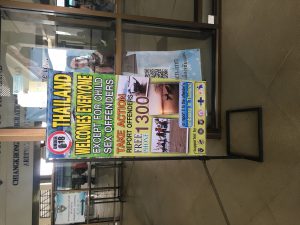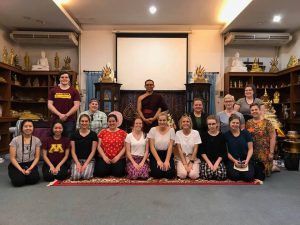There are four members in our group named Jess Bacon, Greta Mertes, Matt Reiser, and Sophie Meads. I am Jess Bacon and my major at the University of Minnesota in Business Marketing with a minor in Management. I came on this trip to experience Thailand and to learn about the culture of the people here. I chose to have the topic of human trafficking because I have always been fascinated by this issue and how the types of trafficking vary by country. My original perception of this problem coming to Thailand was that children were mainly taken for either slavery or prostitution.
My name is Sophie Meads and I am a Family Social Sciences Major at the University of Minnesota, College of Education and Human Development. I chose to come to Thailand this summer for study abroad because I wanted to experience a culture very different from my own to push myself and see a part of the world I had yet to explore. Travel has always been a passion of mine and I love to experience as much diversity as possible, gaining world knowledge about people from all over. Child trafficking is an issue that I am passionate about given how large and quickly the trafficking industry continues to grow, and how many populations it is affecting. It is an issue that needs worldwide awareness and a global effort so I want to do whatever part I can. My original perceptions of child trafficking were that this is an issue that is not particularly affecting one place or population and that child trafficking can look a variety of different ways making it difficult to conquer.
My name is Matt Reiser. I’m majoring in Accounting and Finance with a minor in Business Law. I chose to come to Thailand originally because it seemed like a once-in-a-lifetime opportunity. As the trip came close and I was able to learn what we were going to do on the trip, I became more excited about being able to see the world from a different perspective for a couple weeks. I chose the topic of Child Trafficking because of how prevalent this issue is in Thailand and around the world. My original perception of Trafficking was the typical view of a person being taken and sold as some sort of slave. I also thought that it only happened in developing countries.
Hi, my name is Greta Mertes and I am ending my sophomore year with an experiential learning experience in Thailand. At the University of Minnesota, I am a Family Social Science major with a minor in Spanish. For my topic in Thailand I chose to go more in depth on an issue that doesn’t only find itself in this country but also occurs across international boundaries: sex trafficking and more specifically child trafficking for manual labor or sexual exploitation. I chose to look further into this topic because I didn’t know how prevalent this issue was nor how to identify/go about handling situations that could potentially be exploitation of a child. Prior coming to Thailand, my expectation was that child exploitation was going to be more explicit and obvious; however since being here, I have learned about the implicit ways that children may be coerced or forced to remain in exploited ways that my group talks about below.
Human trafficking is a worldwide problem that isn’t specific to a particular country, but rather an issue that crosses borders and creates a system of its own. There are an estimated 215,000 Cambodian migrants in Thailand, and about 130,000 of those migrants are undocumented, and 15,000 of those are children. Children who are at risk for trafficking come from families in poverty, are often time unemployed and undocumented, therefore minimizing their protection from exploitation. Many of these children are taken from Myanmar, Laos, Cambodia, and northern areas of Thailand. As trafficking gains popularity, these children are being brought to larger, popular tourist locations. Due to the children not being documented, it is more difficult for the government to monitor the movement of children across borders. According to the article that we read before coming to Thailand, Human traffickers can make promises of financial gain and a better life to either the children or the families from poverty-stricken areas. From there, traffickers may break their promises and exploit the children through manual labor, sexual abuse, and using them for street begging.
As part of our experience in this course, we attended a Child Safe Workshop to educate government centers, tourists, and businesses about the potential dangers of unknowingly contributing to the exploitation of children. Child Safe works with kids who are at risk to protect their rights and providing them with resources to prevent further trafficking incidents. When these children come to the country, it is hard for the documented citizen which makes them more at risk. Even though these children are not documented citizens, Child Safe works to give them the same protection that documented children receive. They also work with neighboring countries such as Cambodia, Laos, and Myanmar because they recognize that this is an international problem that is not constricted by borders. They work with and train government staff and centers to be aware of signs of human trafficking because they do not have reliable power to deal with these issues on their own. Corruption in the government is a problem that Child Safe may face when combating human trafficking. Since these human trafficking organizations have been gaining power throughout Thailand and surrounding countries, they may have the financial resources to convince corrupt government officials to turn a blind eye to this issue.
The Child Safe Workshop that we attended provided our class with seven tips to be mindful tourists when traveling around Thailand. Three tips that we found to be especially significant as a tourist are “Children are not tourist attractions, let’s not treat them like they are”, “Volunteering with children feels good but could be harmful – look for better ways to help them”, and lastly “Children pay the price for your generosity – don’t give to begging children”. Often as foreigners, we put children on a pedestal and want to spend time with them, so people will visit child institutions such as schools and orphanages. As an outsider coming into a different environment, we can perceive kids similar to a zoo animal; something to temporarily look at and interact with. We may take photos with them and “try to change their lives,” but end up objectifying them as something we enjoy, instead of the person that they are. Throughout the workshop, we were challenged to think about a foreigner coming into our kids’ schools and taking pictures with them, objectifying them, and potentially exploiting their rights. The second tip that we found important emphasizes the idea of volunteering and around the damage that can be reinforced by temporarily volunteering. Children from an unstable family life may have developed attachment issues and insecurities, or experienced past trauma, making future relationships that much more fragile. When volunteers come into the lives of vulnerable children, it is important they develop a long-lasting, secure relationship. If a volunteer develops this relationship with a child but isn’t there for a prolonged amount of time, may reinforce pre existing attachment issues that a child might have already been dealing with. Finally, the third tip revolves around the idea that providing these resources to children may contribute to either the cycle of poverty in Thailand or to the traffickers that own the child. If the child learns that they can get money from begging, they could lose the incentive to attend school and to make money that capitalizes on their strings. Along with that, traffickers may take the money that the children received off of the streets, for their financial gain. Overall, we found that these tips educated us on the explicit and implicit ways that human traffickers and tourists exploit children.
Initially, we all had the idea that it would be easy to identify children being exploited in Thailand but we learned that there are many underground ways that these organizations can function. Whether this includes taking a picture with a child to objectify a person, giving them short attention, or giving money to a child begging, these are all versions of how the tourist industry contributes to child exploitation. The child-safe workshop provided us with great information to ensure that we were mindful tourists throughout this trip. Child trafficking is an issue in America as well, so we can incorporate these teachings into our everyday life so that we are not contributing to this issue. 

 An experience that has stood out to me thus far on the trip was the Monk Chat that we were able to partake in. Growing up Catholic, I’ve only ever deeply known and understood that one faith. I had never been given the opportunity to hear from a first hand experience about another faith or way of living. Last summer, I tried to push myself to begin learning about other religions, specifically Hinduism and Buddhism. With Google as my best friend, that learning train quickly ended – there were so many details about holidays, traditions, different variations of each religion, different interpretations and variations of X, Y, and Z. It all became so overwhelming that I found myself spending hours on information that provided me with great detail but left me confused on what the main purpose or perspective each religion took.
An experience that has stood out to me thus far on the trip was the Monk Chat that we were able to partake in. Growing up Catholic, I’ve only ever deeply known and understood that one faith. I had never been given the opportunity to hear from a first hand experience about another faith or way of living. Last summer, I tried to push myself to begin learning about other religions, specifically Hinduism and Buddhism. With Google as my best friend, that learning train quickly ended – there were so many details about holidays, traditions, different variations of each religion, different interpretations and variations of X, Y, and Z. It all became so overwhelming that I found myself spending hours on information that provided me with great detail but left me confused on what the main purpose or perspective each religion took.